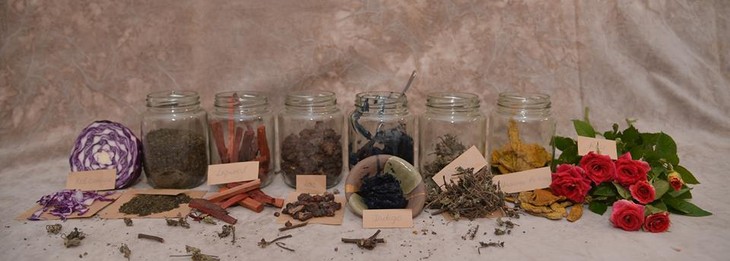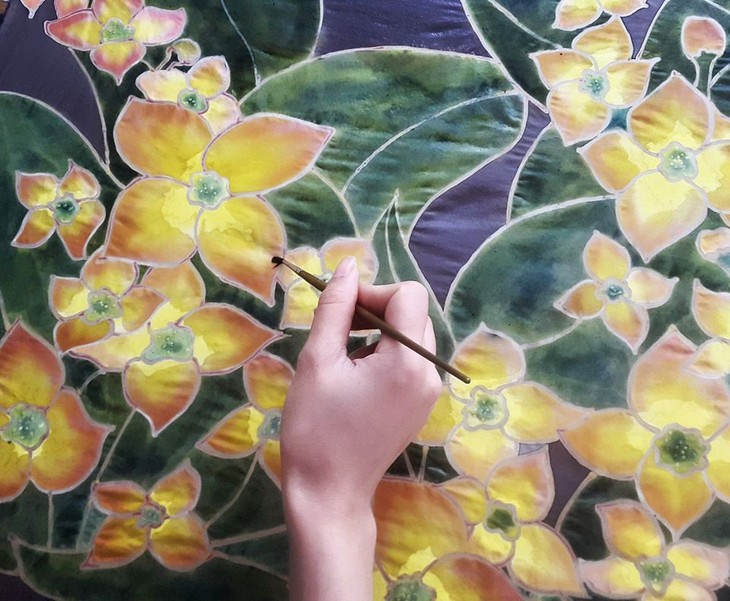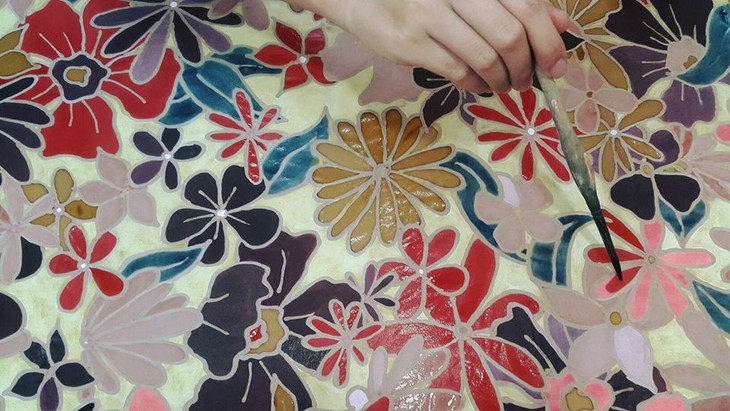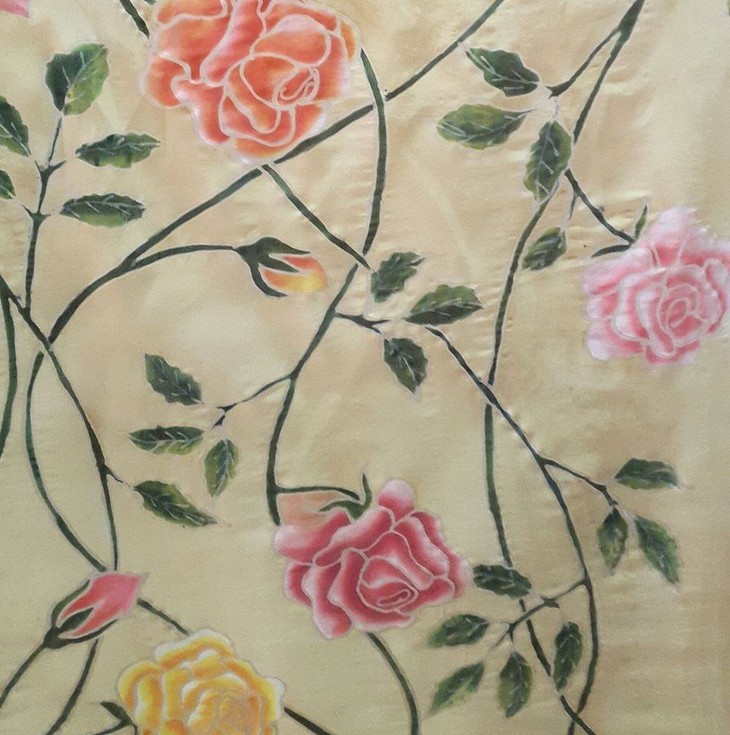(VOVWORLD) - Have you ever thought of dyeing your own clothes…or painting a masterpiece, using natural dyes taken from agricultural waste or plants grown in your own backyard? Did you know natural dyes lie hidden in tree bark, in your kitchen cabinet, and in common plants you see every day? Today let’s follow VOV reporter Viet Anh to a workshop in Hanoi called “Silk painting with natural dyes” to find out how natural dyes are made and used to color fabrics.
It’s a beautiful Sunday afternoon. Some dry weather has arrived just in time for Mother's Day, which is celebrated on the second Sunday of May. I’m browsing the gift shops on Kim Ma Street hoping to find something special with which to surprise my mom. But two hours of fruitless searching has left me feeling sad and discouraged. I turn into alley 371 and spy a small boutique named “Linh Tran Design House”, where beautiful hand-dyed fabrics adorn the walls. Linh Tran, the boutique’s owner, is holding a workshop on using natural dyes to paint on silk.
 The workshop introduces how to use natural dyes to paint on silk. (Source: Linhtrandesignhouse's official FB) The workshop introduces how to use natural dyes to paint on silk. (Source: Linhtrandesignhouse's official FB) |
Looking around the workshop room, I’m surprised to see every corner filled with jars, bowls, boxes, spoons, and chopsticks. There’s also a small electric stove. Am I in the wrong room? No. This is in fact the room where the painting is being done. The kitchen gear is part of it. Linh is explaining things: This workshop is part of a project by the Linh Tran Design House to introduce the various uses of natural dyes in textile art. In previous workshops, I introduced the techniques of dyeing using fresh flowers and agriculture waste such as onion skins, avocado peel, indigo plants, and so on. In this workshop, I’m teaching participants how to paint on silk using those natural dyes. Not all plants and foodstuffs are natural dyes. I often choose tannin-rich plants like logwood, weld (also called dyer’s weed), tea, indigo, turmeric, purple cabbage, pomegranate rinds, and so on. I make the dyes by boiling the raw material in a pan to extract all the color, and cooking it down to make it as condensed as I like.”
 The dyes are made by boiling the raw material in a pan to extract all the color, and cooking it down to make it condensed (Source: Linhtrandesignhouse's official FB) The dyes are made by boiling the raw material in a pan to extract all the color, and cooking it down to make it condensed (Source: Linhtrandesignhouse's official FB) |
So familiar ingredients from your kitchen can be cooked to make colors for dyeing fabric. Workshop participant Hai Anh said: “I prefer the natural way of doing anything, which is why the workshop caught my attention in the first place. I really like the idea of using colors taken from familiar materials rather than buying artificial colors. I also think this is a great opportunity for someone who believes they don’t have any talent for art. Life is made happier through art and creativity, right?”
I learn that not all fabrics can be colored with natural dyes. The best fabrics to use are those made from natural materials like cotton and silk. There are several steps involved in creating a silk painting using natural dyes: for example, lightly transferring your design from paper onto the silk with a vanishing marker and outlining the design with gutta-percha – a natural latex - to keep the dyes from bleeding into each other. Dyes are then applied to the outlined areas just as you would paint with water colors. Painting silk with natural dyes requires proper technique and patience as well as inspiration. Designer Diep Yen, another workshop participant, says:“At this workshop I’ve discovered that painting on silk using natural dyes is different from what I had imagined. Unlike applying acrylic color to fabric, which is super easy, drawing with natural colors requires more experience and skill. You have to pay closer attention. Workshops like this one inspire people’s creativity while encouraging them to use environment-friendly materials.”
 The tannin-rich plants like logwood, weld, tea, indigo, turmeric, purple cabbage, pomegranate rinds are suitable for making dyes (Source: Linhtrandesignhouse's official FB) The tannin-rich plants like logwood, weld, tea, indigo, turmeric, purple cabbage, pomegranate rinds are suitable for making dyes (Source: Linhtrandesignhouse's official FB) |
Linh, the host of the workshop, told participants: “When you paint with dyes, you can create fabric that looks like a watercolor painting, and when you want to dye your clothes, just dip them into the dye solution for a few hours. This technique won’t change the natural texture of the fabric. When you have finished dyeing or painting silk, you should lock in the colors by steaming. The heat from the steam sets the dyes in the silk and makes it permanent. Actually, painting with natural dyes involves a certain amount of experimentation. You may have to try several times to figure out the best way to create your favorite colors. This workshop is not really an art class to teach people how to draw. It’s just a place for me to share my experience in using natural dyes, so anyone can attend the workshop.”
 The best fabrics to use are those made from natural materials like cotton and silk (Source: Linhtrandesignhouse's official FB) The best fabrics to use are those made from natural materials like cotton and silk (Source: Linhtrandesignhouse's official FB) |
 Painting silk with natural dyes requires proper technique and patience as well as inspiration (Source: Linhtrandesignhouse's official FB) Painting silk with natural dyes requires proper technique and patience as well as inspiration (Source: Linhtrandesignhouse's official FB) |
The 4-hour workshop provides detailed explanations of how to create and use natural dyes. With this information, the participants will be able to decorate clothing, soft furnishings, scarves, and many other fabric items. Xuan Hoai, who is passionate about the Vietnamese long dress called ao dai, says that for her the workshop has sparked fresh ideas about painting ao dai with natural dyes. "The workshop was extremely helpful. You know, nowadays, there’s growing concern about environmental issues in the textile industry. Linh’s way of using natural dyes to color fabrics is one way to protect the environment and people’s health. I own an ao dai shop, so I want to apply what I’ve learned from this workshop to my products.”
 Unlike applying acrylic color to fabric, which is super easy, drawing with natural colors requires more experience and skill (Source: Linhtrandesignhouse's official FB) Unlike applying acrylic color to fabric, which is super easy, drawing with natural colors requires more experience and skill (Source: Linhtrandesignhouse's official FB) |
Workshop participant Hoai Anh, says: “I’m a final year student at the University of Fine Arts. Learning how to make and use natural dyes will be very helpful for my dissertation. I think workshops like this one will become more popular as people become more interested in organic and natural clothing options.”
Come try it yourself - 4 hours spent at a Linh Tran Design House workshop could open the door to a whole new world of creativity using natural dyes. I came home with a scarf for my mommy, which I think is the best gift ever for this year’s Mother’s Day.
For more information, check out the boutique’s Facebook page at: linhtrandesignhouse